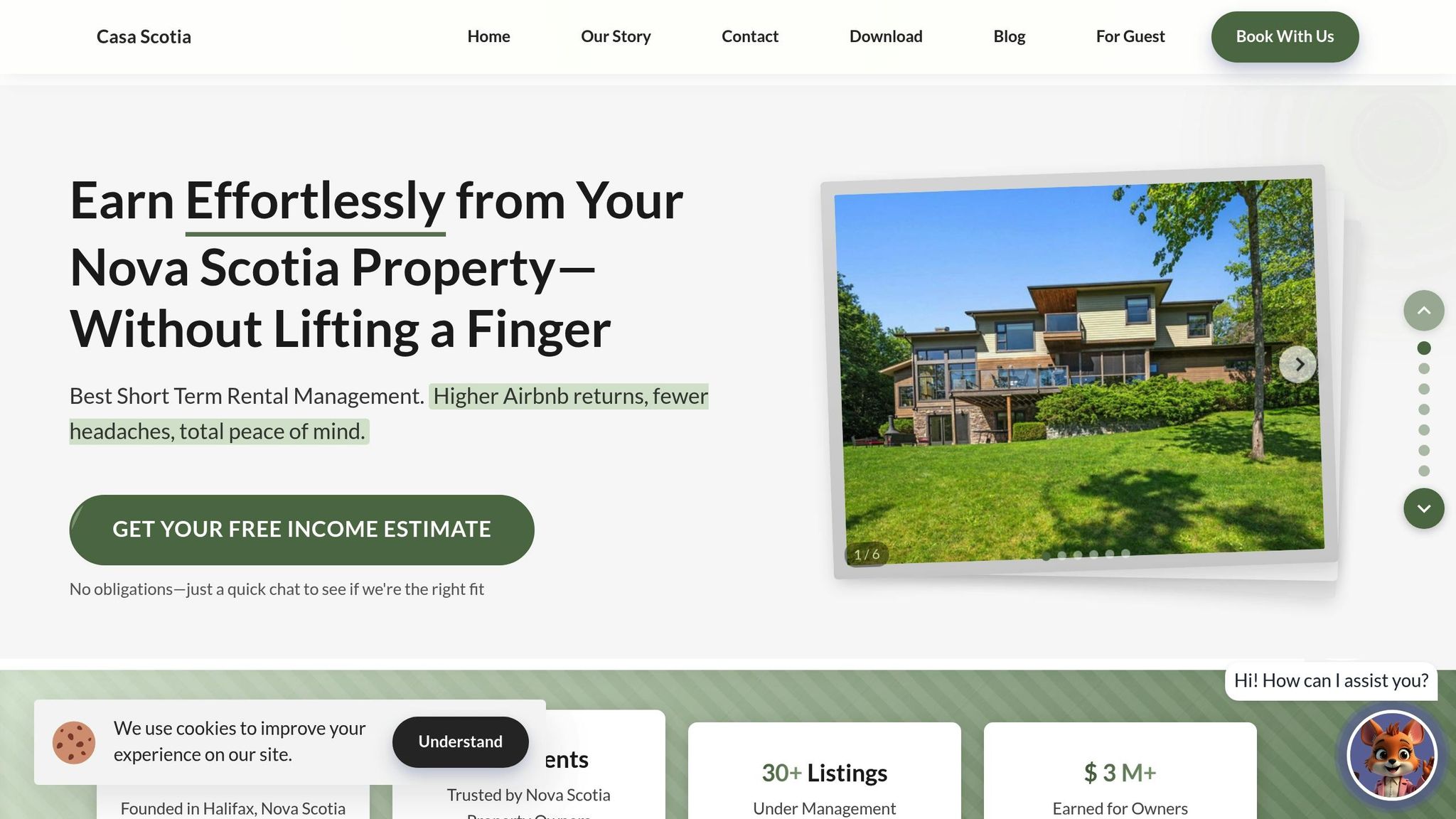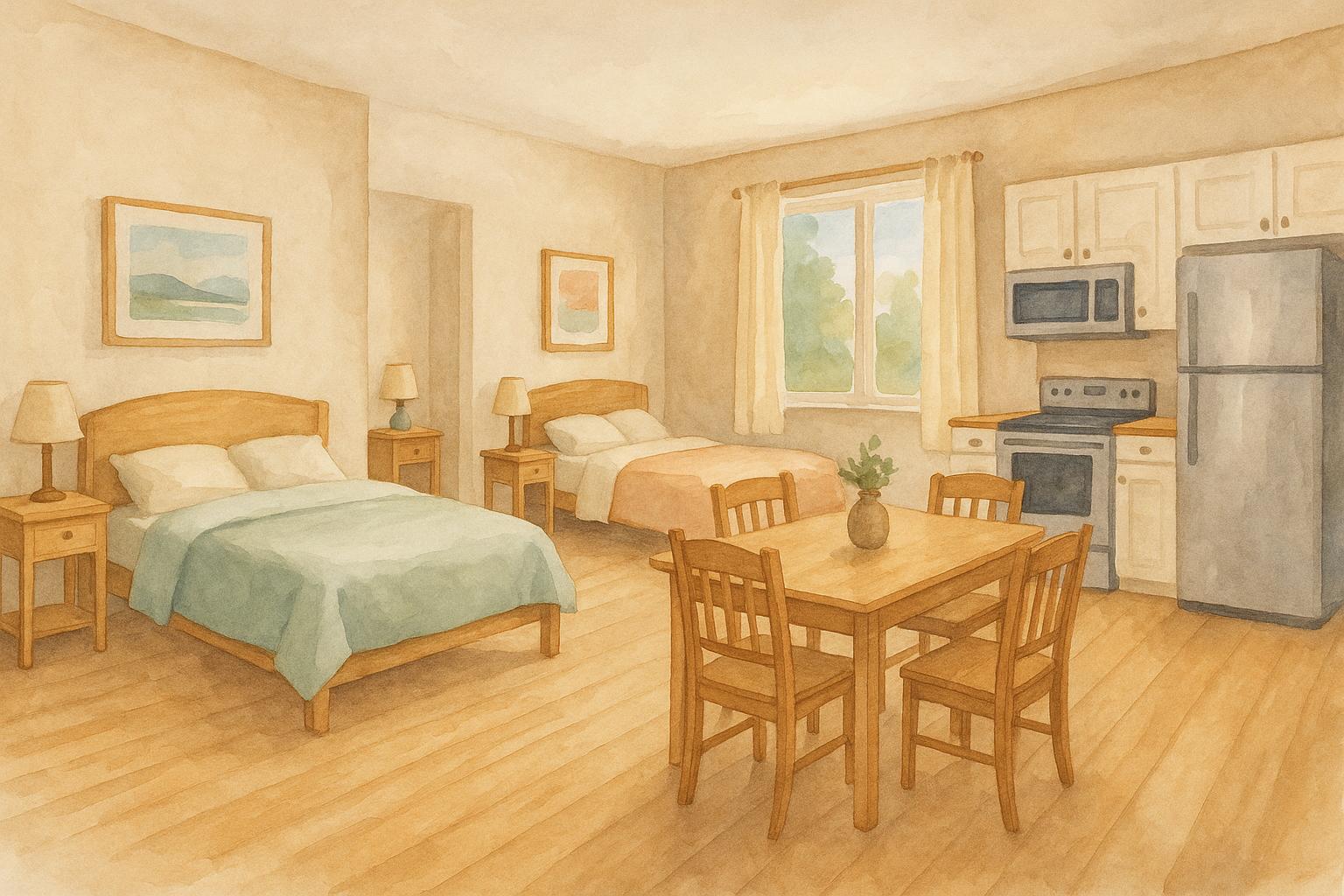Renting part of your duplex or triplex as a short-term rental (STR) while living on-site can boost your income - without breaking zoning laws. Here's what you need to know:
- Partial-Home STRs: Rent out part of your property (e.g., one unit or shared spaces) while remaining the primary resident.
- Zoning Compliance: Follow local rules, such as owner-occupancy requirements, parking standards, and building codes.
- Permits and Inspections: Secure permits, confirm fire safety, and ensure guest spaces meet residential standards.
- Income Potential: Adjust pricing seasonally, offer discounts for longer stays, and monitor competition to stay competitive.
- Case Studies: Examples from Nova Scotia show how duplex and triplex owners successfully balance compliance and profitability.
Transforming a Duplex into a Successful Short-Term Rental Strategy
Zoning Rules for Duplexes and Triplexes in Nova Scotia
Zoning regulations in Nova Scotia differ by municipality, so it’s crucial to check local requirements before setting up a partial-home short-term rental (STR). After that, dive into the by-laws specific to multi-unit properties to ensure compliance.
Key Zoning By-Laws for STRs in Multi-Unit Properties
Many municipalities in Nova Scotia make a clear distinction between full-unit rentals and partial-home STRs, often focusing on maintaining the residential nature of the property. If you live on-site, you may find that certain rules restrict guest accommodations to specific areas of your home. Be sure these guest spaces meet residential standards and confirm that parking arrangements for both you and your guests align with local regulations.
Shared spaces, like kitchens, living rooms, and outdoor areas, might also be subject to rules. Some municipalities require these spaces to remain accessible to the owner. To avoid unintentionally turning your property into a commercial lodging facility, carefully review your local by-laws.
Permit and Inspection Requirements
Before starting your STR, you’ll need to obtain the necessary permits and occupancy approvals. If you plan to make structural changes, such as adding a separate entrance for guests, a building permit is required.
Occupancy permits are typically needed to confirm your property meets safety standards for hosting guests. This includes ensuring fire safety systems and emergency exits are up to code.
If your property uses on-site sewage disposal or a private water source, additional permits or assessments may be required. Local authorities may need to verify that these systems can handle the increased usage from guests. A professional inspection might also be necessary. Once all permits are in place, you’ll be better equipped to avoid compliance missteps.
Common Zoning Mistakes to Avoid
One common error is failing to meet local parking requirements. Don’t assume your driveway space is sufficient - check with your municipality to confirm the number of parking spots needed.
Another frequent issue is using accessory structures, like converted garages, sheds, or basement spaces, for guest accommodations without ensuring they meet residential building standards. Any area advertised for guest use must adhere to local safety and building codes.
Finally, make sure your advertising reflects the exact number of guest-approved rooms. Maintaining owner occupancy is key to keeping your partial-home STR status. If the property is operated solely as a rental, it could trigger zoning rule changes that may complicate your plans.
How to Set Up a Compliant Partial-Home STR in a Duplex or Triplex
Checking Property Eligibility
Start by confirming your property's zoning with your local planning office. You'll need a zoning certificate to ensure your property is eligible for short-term rental (STR) use. Also, verify that guest areas meet building codes and fire safety standards, including proper egress options as required by local regulations.
If your property isn't connected to municipal services, check whether your septic and water systems can handle the increased usage. It's a good idea to have a licensed inspector evaluate your current setup to ensure it can support additional occupants.
Review your insurance policy carefully. Many standard homeowner policies don't cover STR activities, so speak with your provider to explore coverage options before hosting guests.
Once you've confirmed your property's eligibility, focus on designing a layout that clearly separates your living areas from the guest spaces.
Planning Layouts for Compliance
When setting up your guest spaces, aim for a clear division between your private areas and the rental zones. This separation is crucial to maintaining your partial-home STR status. If possible, consider adding separate entrances for guests, but keep in mind that structural changes may require permits.
For shared spaces like kitchens or living rooms, ensure they remain accessible to you in accordance with local regulations. The layout should allow guests to use these areas while still giving you control as the resident owner.
Set a maximum occupancy based on local rules and your property's capacity. Factors like the number of bedrooms, available parking, and septic system limits often determine these occupancy caps.
Parking can also be a key consideration. Check local parking requirements and make sure there's enough space for both your household and your guests. If parking is limited, you may need to explore alternative solutions or adjust the number of guests you accommodate.
Working with Local Authorities
Once your layout and physical requirements are in place, it's time to work with local authorities to secure the necessary approvals.
Start by scheduling a pre-application meeting with your local planning department. This meeting can help flag potential issues early and clarify any specific requirements for your property type.
Prepare thorough documentation for your permit applications. This should include detailed floor plans of guest areas, parking layouts, reports on septic system capacity, and fire safety compliance certificates. A well-prepared application can speed up the process and reduce the chances of needing to provide additional information later.
Coordinate inspections by scheduling building, fire, and health assessments around the same time. This approach can help streamline the process and minimize delays. Keep detailed records of all inspection results and address any required modifications promptly.
After securing approval, stay in touch with local authorities to keep up with any regulatory changes. Building a good relationship with planning and bylaw enforcement staff can help you stay ahead of updates that might impact your STR operations.
Finally, work with qualified professionals when needed. Licensed contractors, certified inspectors, and legal experts can help you navigate complex zoning issues and avoid costly mistakes. Keep copies of all permits, inspection reports, correspondence, and professional assessments as proof of compliance. These records can be invaluable if any questions arise about your STR in the future.
sbb-itb-b5e1074
Maximizing Income While Staying Compliant
Once your short-term rental (STR) is set up in compliance with local rules, the next step is optimizing your income. By using smart pricing strategies and maintaining a high standard of guest management, you can boost your earnings without stepping outside zoning regulations.
Dynamic Pricing and Seasonal Adjustments
In Nova Scotia, seasonal pricing is a must. Summer often sees higher demand, so charging premium rates during the warmer months makes sense. In contrast, offering more competitive rates during winter can help maintain occupancy when demand slows. Tying your pricing to local events and trends also keeps your property attractive year-round.
Discounts for weekly or monthly stays are another effective tool. These can help you secure longer-term guests, reducing the risk of empty nights during slower periods.
Keep an eye on your competition. Regularly monitoring nearby STRs can help you stay competitive. If your property is consistently booked, it might be time to raise your rates. On the other hand, if bookings drop, consider tweaking your pricing or improving your property’s appeal to draw in more guests.
While pricing strategies can help boost revenue in the short term, delivering an excellent guest experience is what ensures long-term success.
Improving Guest Appeal Through Professional Management
The way you present your property can make all the difference. Professional staging and high-quality photography can help your listing stand out, justifying higher nightly rates. Focus on showcasing the unique features of your space, such as private entrances or dedicated guest areas, especially in a partial-home setup.
Guest screening is equally important. Clear communication of house rules and effective guest selection can help prevent potential issues before they arise.
If managing all these aspects feels overwhelming, professional management services are worth considering. They can handle everything from pricing adjustments to guest screening and even compliance, freeing up your time for other priorities.
Don’t overlook the basics, though. Maintenance and cleanliness are critical. A spotless property and prompt attention to any issues can lead to glowing reviews, which, in turn, drive more bookings and repeat visitors.
Comparison: Full-Unit vs. Partial-Home STRs
Choosing between a full-unit rental and a partial-home setup depends on your goals and circumstances. Here’s a breakdown of the key differences:
| Aspect | Full‑Unit STRs | Partial‑Home STRs |
|---|---|---|
| Revenue | Higher nightly rates since the entire property is available | Moderate rates due to shared spaces |
| Compliance | Often more complex, requiring commercial zoning | Easier to comply with residential zoning rules |
| Flexibility | No personal use during guest stays | Allows for personal use alongside rentals |
| Capacity | Entire property available for guests | Limited by shared spaces and local regulations |
| Investment | Higher costs for furnishing the entire property | Lower setup costs with fewer furnishing needs |
| Management | More intensive, with frequent turnovers | Simpler management, often involving the owner directly |
Partial-home STRs offer a unique level of flexibility. You can adjust your rental operations to fit your personal schedule, seasonal fluctuations, or even changing regulations. This approach is particularly appealing for property owners who are new to the short-term rental market or those looking to earn extra income without making significant lifestyle changes.
Case Studies: Successful Partial‑Home STR Setups in Nova Scotia
Examples from Nova Scotia highlight how property owners have successfully worked within zoning regulations to create profitable partial-home short-term rental (STR) ventures. These stories bring to life the zoning rules and income strategies discussed earlier.
Example: Duplex with Owner-Occupied Unit
Sarah MacLeod owns a duplex in Halifax's North End, living in the upper unit while renting out the lower unit as a short-term rental. Her setup not only complies with zoning regulations but also brings in a steady stream of income.
The lower unit is fully self-contained, with its own entrance and amenities, ensuring compliance with zoning laws and providing guests with privacy. By living upstairs, Sarah meets the owner-occupancy requirement.
During the summer, she charges between CA$150 and CA$180 per night, while winter rates range from CA$95 to CA$120. With an occupancy rate of 75%, her annual revenue from the rental reaches about CA$45,000. Separate utility meters installed for the lower unit help her track costs accurately, with monthly utility expenses averaging CA$85–95.
To secure her STR permit, Sarah demonstrated compliance by submitting floor plans that outlined the separate living spaces, proof of owner-occupancy via utility bills and voter registration, and evidence of adequate parking with her two-space driveway.
To maintain a peaceful relationship with her neighbours, Sarah enforces a three-night minimum stay for guests, reducing turnover and potential disruptions in the neighbourhood.
Example: Triplex with Shared STR Spaces
David Chen’s triplex in Dartmouth takes a more intricate approach. He resides in one unit, rents another to a long-term tenant, and operates the third unit as a short-term rental. The STR unit features a private bedroom, bathroom, and kitchenette, while guests share access to communal spaces like a recreation room, laundry facilities, and the backyard.
This setup not only maximizes the property’s appeal but also keeps individual unit sizes manageable for zoning compliance. The STR unit generates approximately CA$38,000 annually, while the long-term rental provides consistent monthly income of CA$1,200. With his own housing costs covered, David earns a net positive cash flow of about CA$2,800 each month.
To comply with Dartmouth’s regulations, David limits STR bookings to two guests, adhering to the rule of no more than four unrelated adults per property. He added three parking spaces by converting part of his front yard, fulfilling municipal parking requirements.
David took additional steps to ensure harmony between tenants and guests. He established clear rules for shared spaces, including access times and responsibilities, and installed separate utility panels to monitor usage. These measures have helped prevent conflicts.
Recognizing the unique risks of his mixed-use property, David switched to a commercial insurance policy that covers both residential and STR activities. While this costs an extra CA$180 monthly, it provides peace of mind and comprehensive coverage for his setup.
Conclusion: Balancing Profitability and Compliance
From zoning rules to operational strategies, running partial-home short-term rentals (STRs) in Nova Scotia requires a careful mix of following regulations and maximizing income, as highlighted by local examples.
Key Takeaways for Property Owners
To maintain a successful and compliant STR, here are the main principles to keep in mind:
- Zoning compliance is non-negotiable. Meeting requirements like owner-occupancy, separate entrances, and adequate parking isn’t just about ticking boxes - it’s about safeguarding your investment and ensuring long-term success.
- Understand your income potential. Factors like location, property setup, and management style can greatly influence earnings. Urban properties in high-demand areas might see strong nightly rates during peak seasons, while others may face different market dynamics. Adjusting pricing based on local demand and seasons is crucial. Properties with separate utility meters and clearly defined spaces often perform better, thanks to easier cost tracking and clearer expectations for guests.
- Professional management pays off. Hiring professional management can lead to higher occupancy rates, better reviews, and fewer compliance headaches. Services like professional cleaning, dynamic pricing, and guest screening often result in increased bookings and shorter vacancy periods, making the investment worthwhile.
- Don’t skip insurance and risk management. Having proper commercial insurance is essential. It shields you from potential financial losses due to liability claims or property damage, giving you peace of mind.
Casa Scotia: Your Partner in STR Success

Navigating Nova Scotia's STR regulations while maximizing income can be challenging, but Casa Scotia offers the local expertise you need. Their services are designed to tackle the dual challenges of compliance and profitability, especially for duplex and triplex owners.
Casa Scotia provides a full-service management package that includes regulatory compliance, guest screening, and reporting. They also use dynamic pricing tools to help properties secure top rates during busy seasons while staying competitive during slower periods.
With Casa Scotia's owner portal, you get real-time updates and detailed monthly performance reports. This level of transparency is especially useful for multi-unit properties, where tracking the financial performance of each unit is critical for making smart decisions.
Whether you opt for their Year‑Round Management to ensure steady income throughout the year or Peak‑Season Management to focus on summer profits, Casa Scotia’s deep understanding of the local market ensures your property operates at its best while staying fully compliant with Nova Scotia’s STR rules. Let Casa Scotia handle the hard work so you can enjoy both profitability and peace of mind.
FAQs
What zoning rules should I follow to set up a legal partial-home short-term rental in a duplex or triplex in Nova Scotia?
To legally operate a partial-home short-term rental in a duplex or triplex in Nova Scotia, there are a few important rules to keep in mind:
- Registration: You’re required to register your short-term rental with the Tourist Accommodations Registry. This step is mandatory for all short-term rental operators.
- Zoning Compliance: Make sure your rental complies with municipal land use by-laws. Depending on the specifics of your rental, you may need a Zoning Confirmation Letter or a Development Permit.
- Primary Residence: If your property is in a residential zone, short-term rentals are only permitted if the rental is part of your primary residence.
By meeting these requirements, you can ensure your rental operates within the law while making the most of your property.
What steps should I take to ensure my short-term rental meets safety and building standards in Nova Scotia?
To operate a short-term rental in Nova Scotia, you need to ensure your property meets both municipal and provincial safety and building standards. This includes registering your rental with the Tourist Accommodations Registry, which requires proof that your property complies with local land use by-laws.
Depending on where your property is located, you might need a Zoning Confirmation Letter or a Development Only Permit to verify that your rental aligns with zoning regulations. Additionally, all residential rental properties must adhere to minimum safety standards, which could require inspections or certifications. It's essential to consult your local government for detailed requirements to ensure your rental is fully compliant.
How can I legally maximize income from a partial-home short-term rental in a duplex or triplex?
To make the most of income from a partial-home short-term rental in a duplex or triplex while staying on the right side of local laws, the first step is registering your property with the Tourist Accommodations Registry. If you're in Nova Scotia, this registration is mandatory, and you'll need to include your registration number in your rental listing.
Next, take some time to understand local zoning regulations. For instance, in Halifax, short-term rentals are permitted in residential zones, but only if they are part of the owner's primary residence. If you're planning to run a commercial short-term rental, the property must be located in a zone that allows this. You might also need a Zoning Confirmation Letter or a Development Permit from your local municipality, so double-check these requirements.
Lastly, pay attention to rental duration rules. In Halifax, rentals of 28 days or fewer come with specific restrictions. Make sure your rental setup aligns with these guidelines. By staying informed and following these steps, you can strike a balance between earning income and staying compliant with local regulations.
Related Blog Posts
- Short term rental regulation in HRM ( Halifax, Bedford, Dartmouth )
- Short-Term Rental Regulations in Nova Scotia: Northumberland Shore (Tatamagouche, Pugwash)
- Halifax, Dartmouth, Bedford and Sackville: Where STRs Are Allowed and What Permits You Need
- Backyard/Garden Suites as STRs: When They Count as Commercial and What to Do



